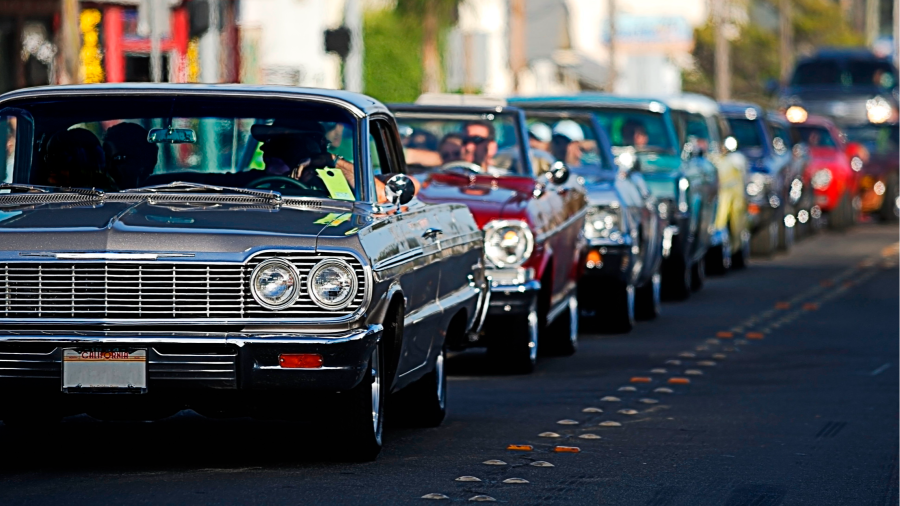
On a warm Saturday night in August, Sal Preciado parked his gleaming 1971 Monte Carlo on Sunset Boulevard in front of El Clásico, the tattoo parlour he has owned for the past 14 years. All evening, Sal and his friends watched as a procession of “low-riders” — lavishly customised classic American cars — rumbled up and down the boulevard past his shop.
It was an old school Los Angeles cruise, one that Sal had organised, and the mood along Sunset was festive. Some of the low-riders were tricked out with hydraulics that made the enormous steel cars bounce like bedsprings, while others had “scrape plates” that left trails of sparks flying off the pavement. Throngs of dancing, beer-drinking Angelinos on both sides of Sunset cheered at the automotive acrobatics.
I thought about the low-riders a couple of weeks later when California governor Gavin Newsom enacted his plan to phase out sales of petrol-fuelled cars by 2035, part of the state’s goal of reaching zero carbon emissions by 2045. The policy was groundbreaking, a first in the US.
But Newsom’s initiative also set in motion what was probably an inevitable collision between two of California’s defining traits: its cutting-edge environmental policy and its citizens’ almost erotic love affair with the car.
There is no question which side Sal is on. He’s got nothing against protecting the environment, but he also cannot find anything to like about electric cars.
“I can’t even imagine electric low-riders,” he told me, adding that driving customised, gas-guzzling American cars is a defining part of life in his native East LA. “We all lowride. It’s part of the California culture. Everybody likes these cars, man — American-made cars.”
A growing number of Californians are starting to like electric cars, too. California leads the US in electric car sales, and in the first five months of the year more than 28 per cent of cars sold in the state were either electric or hybrid vehicles, according to the California Auto Outlook. The Tesla Model Y, a luxury electric SUV, was the best-selling vehicle of any type in California in the first quarter of this year.
The extreme weather in California earlier this month — temperatures reached record highs across the state, stretching the electricity grid to the limit — was a reminder of why its citizens may feel more urgency on climate change than those of other US states. But California has always been a pioneer on environmental policy, particularly when it comes to automobiles.
It introduced rules in the 1960s that limited motor vehicle exhaust emissions, and later set high standards for fuel efficiency in cars that were widely followed elsewhere. In 2006, California launched the first comprehensive greenhouse gas regulatory programme in the US. Some argue that Newsom’s electric car push is not great for the environment, given the amount of mining required for the batteries. It will, however, reduce the carbon emissions from autos.
Yet California also practically invented car culture, then packaged it and exported it to the world via rubber-burning evangelists from the Beach Boys to Dr Dre, American Graffiti to The Fast and the Furious. On the cinema screen and on the radio, fast cars are still powered by petrol.
In his classic work on California’s custom car culture, The Kandy-Kolored Tangerine Flake Streamline Baby, Tom Wolfe tells the origin story of hot-rodding, which he dates to the mid-1940s. It was a “lurid” time of “weird-looking roadsters and custom cars, with very loud varoom-varoom motors” — and lots of highly illegal drag racing.
That outlaw, “varoom-varoom” spirit was revived during the pandemic, when LA’s usually jam-packed roadways were suddenly free and clear — allowing drivers of the new generation of American muscle cars to literally take over the streets.
Instead of drag racing, these “takeovers” — also known as “side shows” — usually involve huge crowds of people standing in an intersection while cars squeal at high speeds in tight circles. There have been about 705 takeovers this year — and six deaths associated with them.
When it’s all over, the air is filled with thick grey smoke and intersections are indelibly covered in black tyre marks. Many takeovers have been captured on YouTube and TikTok, fuelling their popularity even more.
It might be hard to see how high-octane speed junkies like the takeover drivers could be persuaded to move to a practical electric vehicle in 2035, state rule or no state rule.
But Tesla has already shown that electric cars can be fast; the Model S can reach 200 miles an hour (322km/hr). Perhaps more significantly — at least in terms of building the electric vehicle’s credibility in hot rod circles — an unknown Tesla driver performed an incredibly dangerous jump in East LA this year that was viewed millions of times online. (It ended with a crash into a two parked cars. It goes without saying that such stunts are not a good idea.)
Sal remains unmoved. “I hate Teslas,” he says. “There’s nothing cool about them. Give me a nice Chevy — something with character.”